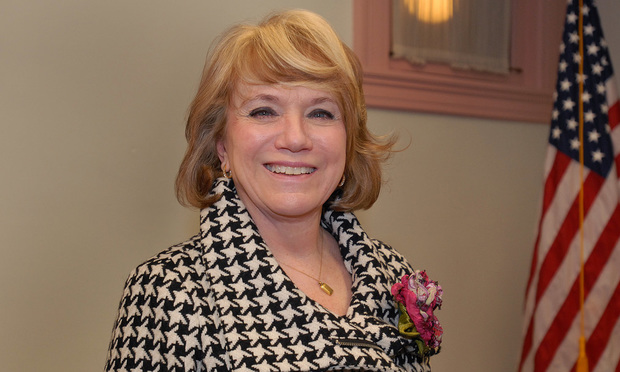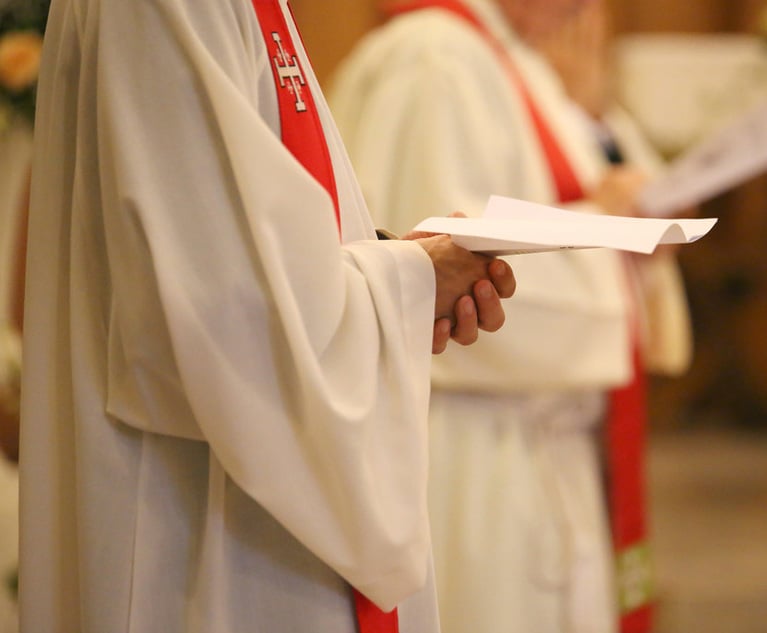Law Grad's $221K Loan Discharge Has Bankruptcy Bar Buzzing
A decision by the chief bankruptcy judge of New York's Southern District is throwing cold water on the conventional wisdom that student loans are not dischargeable in bankruptcy, and it could influence how other judges determine whether borrowers face undue hardships.
January 09, 2020 at 05:15 PM
5 minute read
 Judge Cecelia Morris. Photo: Rick Kopstein
Judge Cecelia Morris. Photo: Rick Kopstein
Did a 2004 Cardozo law graduate-turned hiking guide just make it significantly easier for other J.D.s drowning in debt to discharge their student loans?
Stay tuned.
Bankruptcy experts are buzzing over an unusual decision issued Jan. 7 by Chief Judge Cecelia Morris of U.S. Bankruptcy Court for the Southern District of New York that enables law grad Kevin Jared Rosenberg to discharge the $221,000 loan debt he acquired as an undergraduate at the University of Arizona and later at the Cardozo School of Law. The win by Rosenberg, who represented himself in the matter, flies in the face of conventional wisdom that says student loan debt is all but impossible to shed in bankruptcy.
It's the bankruptcy judge's application of the so-called "Brunner test"—which lays out the three criteria student loan borrowers must meet to demonstrate that repaying their loans poses an undue hardship—that has caught the attention of the bankruptcy law world. Morris' opinion includes a strongly worded rebuke of how judges have traditionally applied the Brunner test, saying they have made it more onerous on borrowers than it was intended to be.
"Over the past 32 years, many cases have pinned on Brunner punitive standards that are not contained therein," Morris wrote. "Those retributive dicta were then applied and reapplied so frequently in the context of Brunner that they have subsumed the actual language of the Brunner test. They have become a quasi-standard of mythic proportions so much so that most people (bankruptcy professionals as well as lay individuals) believe it impossible to discharge student loans."
Jason Iuliano, a professor at Villanova University Charles Widger School of Law who has been studying student loan discharges since 2010, said he's not surprised that Morris sided with Rosenberg. His research shows that about 40% of the borrowers who ask a judge to determine that they meet the undue hardship criteria and discharge their student loans are successful. That's despite the widespread belief that such requests are almost always denied in court. (Of note is that a mere 400 to 500 borrowers a year ask a judge for a discharge, out of the approximately 250,000 student loan borrowers who declare bankruptcy annually.)
Even so, Iuliano said Morris' rebuke of how the Brunner test has historically been applied was unusual.
"It's the first time I've seen a judge call out the undue hardship standard so forcefully and attack the idea that the test is so burdensome," Iuliano said. "Even other judges who were granting discharges were finding ways to not call out the test this explicitly, and to fit [their opinions] within the existing standard."
To meet the Brunner test, borrowers must demonstrate that their current income does not enable them to maintain a "minimal" standard of living while repaying their loans, that their financial situation is likely to persist for a "significant portion" of their repayment period, and that they have made good faith efforts to repay their loans.
Matthew Bruckner, a professor at Howard University School of Law and a bankruptcy expert, said Morris' application of the second two prongs of the test in the Rosenberg case are somewhat unusual. Rosenberg claimed in court that his annual income as an outdoor guide is $37,000 and that he has a negative monthly outlay of $1,500. But Morris did not consider any potential increase in his earnings on the grounds that the entirety of his $221,000 loan balance is due because he went into default. Judges typically take a 10 or 25-year view of earnings based on the length of the repayment plan.
Similarly, Morris declined to use Rosenberg's decision not to pursue a legal career—he practiced law for just a few months after graduating from Cardozo—as evidence that he has not made a good faith effort to repay his loans.
"Right now, he can't repay," Bruckner said. "But he's got a law degree. What if he decided he wanted to be an associate at Wachtell and they would hire him? Then his income would spike. She doesn't hold against him his failure to be working as a lawyer, whereas lots of other judges have."
In finding that Rosenberg made a good faith effort to repay his loans, Morris credits him with making about 40% of his required loan payments, even though he was only required to make 26 payments over the course of 13 years due to securing multiple loan deferrals, Bruckner noted.
"There is some view—I don't know how well informed—that judges are increasingly eager for a different way of thinking about student loan discharge," Bruckner said. "In that case, Morris' decision could point them to a path forward that they can square themselves with intellectually."
But whether Rosenberg's case has any larger legal ramifications will likely boil down to whether Morris' decision is upheld on appeal. If the U.S. Court of Appeals for the Second Circuit sides with Morris, for example, that could open to door for more borrowers to see their loans discharged, Iuliano said.
For now, the biggest impact of the case may well be raising awareness among the bankruptcy bar that student loans are, in fact, dischargeable, he said.
"The important upshot of the case is that it's getting attention and bringing it to the knowledge of attorneys that, 'Hey, student loan debt is dischargeable,'" Iuliano said. "So many attorneys that I talk to think it's categorically non-dischargeable, and that's the advice they give their clients."
This content has been archived. It is available through our partners, LexisNexis® and Bloomberg Law.
To view this content, please continue to their sites.
Not a Lexis Subscriber?
Subscribe Now
Not a Bloomberg Law Subscriber?
Subscribe Now
NOT FOR REPRINT
© 2025 ALM Global, LLC, All Rights Reserved. Request academic re-use from www.copyright.com. All other uses, submit a request to [email protected]. For more information visit Asset & Logo Licensing.
You Might Like
View All
Librarian's Termination Violated First Amendment Protections, Lawsuit Claims
3 minute read
Divided State Supreme Court Clears the Way for Child Sexual Abuse Cases Against Church, Schools

Longtime Purdue GC Accused of Drunken Driving Hires Big-Name Defense Attorney
3 minute read
LSU General Counsel Quits Amid Fracas Over First Amendment Rights of Law Professor
7 minute readTrending Stories
- 1Data Breaches in UK Legal Sector Surge, According to ICO Data
- 2PayPal Faces New Round of Claims; This Time Alleging Its 'Honey' Browser Extension Cheated Consumers
- 3Fired NLRB Member Seeks Reinstatement, Challenges President's Removal Power
- 4NY Inspector General Announces Attorneys Hired to Lead Upstate Region and Gaming
- 5Carol-Lisa Phillips to Rise to Broward Chief Judge as Jack Tuter Weighs Next Move
Who Got The Work
J. Brugh Lower of Gibbons has entered an appearance for industrial equipment supplier Devco Corporation in a pending trademark infringement lawsuit. The suit, accusing the defendant of selling knock-off Graco products, was filed Dec. 18 in New Jersey District Court by Rivkin Radler on behalf of Graco Inc. and Graco Minnesota. The case, assigned to U.S. District Judge Zahid N. Quraishi, is 3:24-cv-11294, Graco Inc. et al v. Devco Corporation.
Who Got The Work
Rebecca Maller-Stein and Kent A. Yalowitz of Arnold & Porter Kaye Scholer have entered their appearances for Hanaco Venture Capital and its executives, Lior Prosor and David Frankel, in a pending securities lawsuit. The action, filed on Dec. 24 in New York Southern District Court by Zell, Aron & Co. on behalf of Goldeneye Advisors, accuses the defendants of negligently and fraudulently managing the plaintiff's $1 million investment. The case, assigned to U.S. District Judge Vernon S. Broderick, is 1:24-cv-09918, Goldeneye Advisors, LLC v. Hanaco Venture Capital, Ltd. et al.
Who Got The Work
Attorneys from A&O Shearman has stepped in as defense counsel for Toronto-Dominion Bank and other defendants in a pending securities class action. The suit, filed Dec. 11 in New York Southern District Court by Bleichmar Fonti & Auld, accuses the defendants of concealing the bank's 'pervasive' deficiencies in regards to its compliance with the Bank Secrecy Act and the quality of its anti-money laundering controls. The case, assigned to U.S. District Judge Arun Subramanian, is 1:24-cv-09445, Gonzalez v. The Toronto-Dominion Bank et al.
Who Got The Work
Crown Castle International, a Pennsylvania company providing shared communications infrastructure, has turned to Luke D. Wolf of Gordon Rees Scully Mansukhani to fend off a pending breach-of-contract lawsuit. The court action, filed Nov. 25 in Michigan Eastern District Court by Hooper Hathaway PC on behalf of The Town Residences LLC, accuses Crown Castle of failing to transfer approximately $30,000 in utility payments from T-Mobile in breach of a roof-top lease and assignment agreement. The case, assigned to U.S. District Judge Susan K. Declercq, is 2:24-cv-13131, The Town Residences LLC v. T-Mobile US, Inc. et al.
Who Got The Work
Wilfred P. Coronato and Daniel M. Schwartz of McCarter & English have stepped in as defense counsel to Electrolux Home Products Inc. in a pending product liability lawsuit. The court action, filed Nov. 26 in New York Eastern District Court by Poulos Lopiccolo PC and Nagel Rice LLP on behalf of David Stern, alleges that the defendant's refrigerators’ drawers and shelving repeatedly break and fall apart within months after purchase. The case, assigned to U.S. District Judge Joan M. Azrack, is 2:24-cv-08204, Stern v. Electrolux Home Products, Inc.
Featured Firms
Law Offices of Gary Martin Hays & Associates, P.C.
(470) 294-1674
Law Offices of Mark E. Salomone
(857) 444-6468
Smith & Hassler
(713) 739-1250








